
What is Agile Methodology, and Why Should You Embrace it for Software Development?
What is Agile Methodology? – First question everyone should ask himself/herself when starting software development.
How do organizations like Google and Microsoft manage to update their every product in just a week or two while other firms take a few months or even years?
Software project management is a complicated sphere. There is a myriad of procedures, methodologies, and practices that differ not just within industries or companies but across the whole project management field itself.
But one thing is for sure, those teams following a ‘traditional’ software development method (such as Spiral or Waterfall) are much likely to spend months and years creating a product before releasing it to users.
Agile methodology turns such a process upside down.
Since 2015, this particular project management trend has been steadily rising. In fact, 71% of companies have used Agile approaches, and 98% have benefited from Agile adoption in 2020.
But with all the buzz and noise of Kanban, Scrum, XP, or any other software development practices, you can easily lose sight of what Agile development is and how it actually works.
So, what is Agile all about? And how will it help you to kick start your software development venture?
We have had the same questions. However, we did our research and embraced both Agile and Waterfall to learn what works and what does not. Needless to say, the prior had a notable impact on our workflows, quality of products, and how we collaborate.
Hence, here we have compiled all our insights into this guide that explains everything about Agile and whether it’s a right fit for your business.
Let’s dive in!
What is Agile Methodology in Software Development?
Agile is a modern practice in project management that has arisen in the last few years and flipped the software development world on its head. With an iterative approach to software development methodologies, developers use a number of Agile techniques to schedule releases and work in time-bound ‘Sprints’ to learn from customer feedback and launch new products.
In simple words, Agile practices allow you to break a large-scale project into small iterations and produce great value at the end of each iteration.
Agile SDLC (software development life cycle) creates a tight “feedback loop” between developers and customers that helps teams react quickly to market needs and customer demands, collaborate better, and optimize the development speed.
A Brief History of Agile Software Development and Its Rise
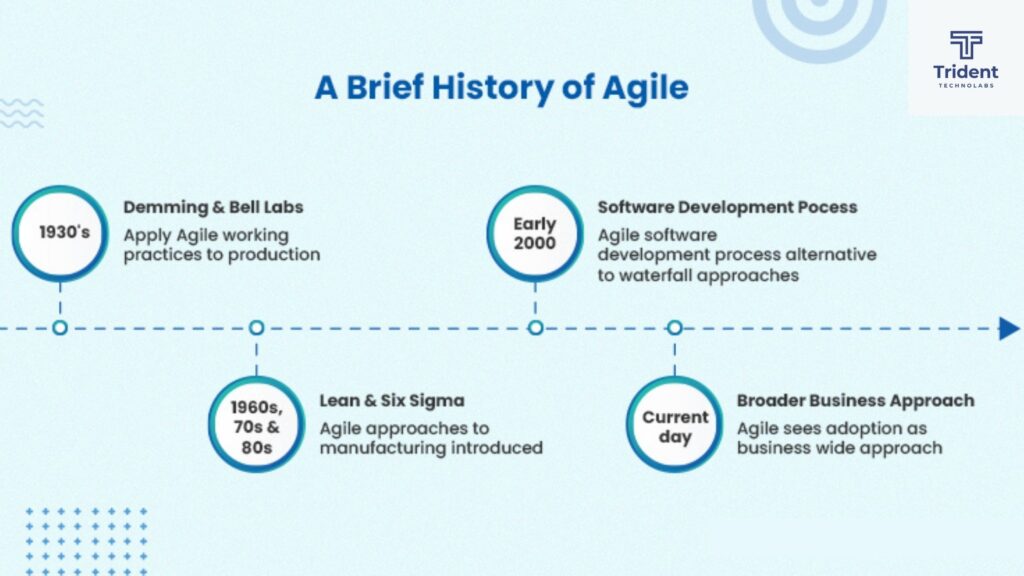
Although Agile has become the go-to methodology for almost every prominent software development company (from Facebook to Microsoft to Apple), it was not always the case.
Even until the past decade, organizations used to follow traditional project management methods, like the Waterfall, for most projects. Such outdated practices heavily relied on complex processed and long-drawn-out deadlines. Teams needed to chalk out the whole development process first and then work on it consecutively before they could release it to end-users.
This means you would invest a significant amount of money, resources, and time into something you did not even know would be successful.
Working hard on a product that never saw the daylight is a familiar symptom of corporate bureaucracy and, unfortunately, a serious morale-killer.
And such issues kept piling up.
So, on one fine day in 2001, 17 software developers gathered up and formed a self-titled group to brainstorm a viable alternative solution that would allow less heavy documentation and a faster development process.
In other words, they were looking for the right strategic plans for successful software development.
And this groundbreaking decision led to the creation of the Agile Manifesto.
Those 17 organizational anarchists discovered a common ground and decided to create value-based software development practices that ensure project success.
So, they built a non-profit organization and outlined 12 principles and 4 core values of Agile software development (which we will describe soon). Any team looking to adopt the Agile process can access their information and resources.
Ever since, Agile has become the most sought-after project management methodology in the software development world, with 97% of organizations using this method.
The 4 Core Values of Agile Project Management
In its essence, Agile is more of a philosophy than a methodology; meaning, while you can implement Agile practices in different ways, they all share a common set of beliefs that explicitly set them apart from traditional development processes.
If you want to properly implement the Agile methodology steps, it becomes essential to understand its core values.
1. Individual and interactions over processes and tools
2. Working software over comprehensive documentation
3. Customer collaboration over contract negotiation
4. Responding to change over following a plan
Do these core values imply you should pay no attention to plans, tools, and documentation you have worked so hard to create?
Not at all.
Boiled down, the primary focus of Agile software development is based on iteration, collaboration, trust, prototypes, and last but not least, people.
In other words, the Agile mindset empowers you to focus on people, value customers, build efficient software, align with the latest software development trends, and look for better ways to improve.
The 12 Key Principles of Agile Project Management
Although the four principles give you the needed insights to understand the Agile system, the overall concept is still a bit vague.
This is why the 17 Agile founders drafted 12 key principles in the Agile Manifesto. In their own words, the principles are:
1. Our highest priority is to satisfy the customer through early and continuous delivery of valuable software.
Launching products early and getting continuous feedback is the key to customers’ and stakeholders’ satisfaction. Agile teams aim to build an MVP as early as possible and listen to the feedback of real users. Traditional development differs here as you have to put aside the product till it is fully formed and perfect.
2. Welcome changing requirements, even late in development. Agile processes harness change for the customer’s competitive advantage.
Here, the emphasis is on embracing changing needs rather than proceeding without them. So, your team will be receptive to changing market demands, customer requirements, and competitive outlook. If there’s a benefit in changing course, Agile teams do so.
3. Deliver working software frequently, from a couple of weeks to a couple of months, with a preference to the shorter timescale.
Agile developers work on smaller components of a product and deliver them regularly. This approach not only accelerates the development time but offers great opportunities to validate objectives and strategies.
4. Business people and developers must work together daily throughout the project.
Frequent communication between the development team and stakeholders is of great importance in Agile. If you want to deliver successful software, gather insights from both business and technical sides of your company for enhanced transparency, trust, and alignment.
5. Build projects around motivated individuals. Give them the environment and support they need, and trust them to get the job done.
Instead of unnecessary hand-holding and micromanagement, Agile empowers you with autonomy and trust. Hence, ensure you have the right people in the team and provide them with adequate resources to complete your project.
6. The most efficient and effective method of conveying information to and within a development team is face-to-face conversation.
The Agile model in software development heavily stresses the need for transparent communication, whether over a video call or in real-time. This ensures the elimination of any misunderstanding that may occur when you communicate via messages or emails.
7. Working software is the primary measure of progress.
As mentioned above, Agile teams opt for MVP software development and estimation at the earliest instead of aiming for perfection in one go. With a “fail first” approach, they validate their ideas quickly and develop efficient software.
8. Agile processes promote sustainable development. The sponsors, developers, and users should be able to maintain a constant pace indefinitely.
If you plan a rapid release of your product, it can be stressful most of the time. Agile empowers you to set realistic goals, avoid fatigue, and boost morale.
9. Continuous attention to technical excellence and good design enhances agility.
Agile development requires you to be extra careful with technical implementation and its impact on the functionality and features of your software. Your development team must work with stakeholders to figure out when they can accept technical debt.
10. Simplicity – maximizing the work not done – is an essential element.
The goal here is to align your services and products with value-driven resources and people. Agile empowers you to define customer value and establish priorities based on it. It also means treating the professionals properly and keeping the pipe clean.
11. The best architectures, requirements, and designs emerge from self-organizing teams.
Contrary to traditional project management, where management only makes crucial decisions, Agile practices allow your team to be self-organized by creating a uniform structure and enabling everyone to make key decisions as a team.
12. At regular intervals, the team reflects on how to become more effective, then tunes and adjusts its behavior accordingly.
This principle written in the manifest0 for Agile software development highlights the responsiveness to changes in workflow, team structure, and process. In order to create a profitable product, your team needs to reflect on and adjust their behavior.
To summarize, users mostly care about efficient software, not documentation. They are not interested in your deep-rooted strategy but in a new product. If your software has a bug, they would expect you to fix it in a few days. If it takes months, they are likely to find an alternative.
Agile methodology is the best way to cater to such demands of needy customers.
Popular Methodologies in Agile Development
Let’s face it – every organization has its own external and internal factors that vary from others. Whether or not you are adopting Agile practices depends on how you go about accomplishing agility.
Despite the Agile vs DevOps debate and other common talks, Agile itself is not a very hard concept to grasp. However, like any other method or tool, it has its own quirks and nuances that you must figure out if you want to scale it across your business.
Let’s go through some of the most popular Agile methodologies and decide the right one for your organization.
Scrum
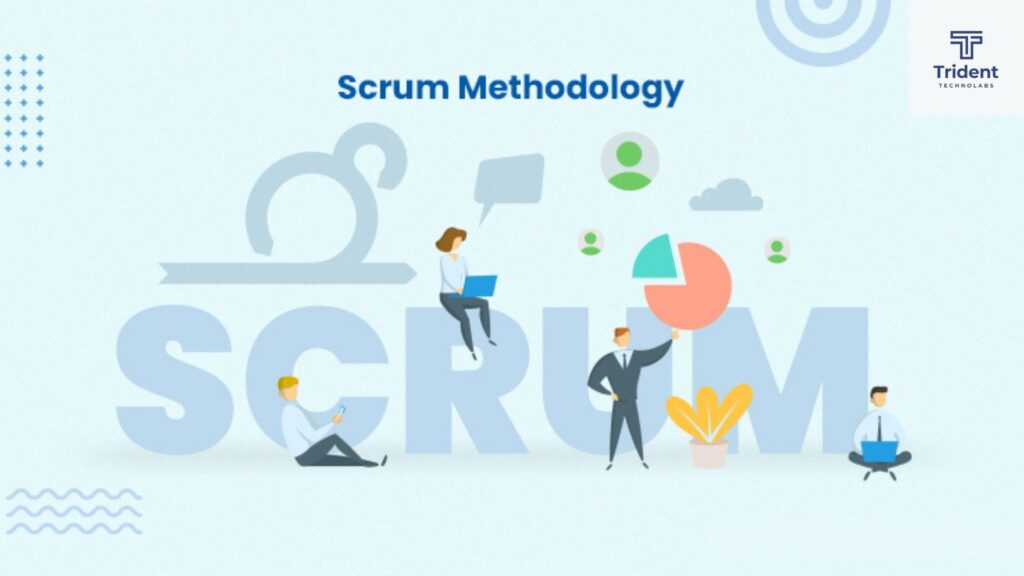
This is the most well-known Agile methodology that uses a gradual and iterative process for executing projects. It enables you to be flexible and responsive to changes more quickly.
Developed in the 1990s, the Agile Scrum methodology depends on a set of time-bound sprints but with a bit more prescriptiveness on how you put together the sprints. It is based on the rugby game where the whole team strives to move forward together with certain principles like:
- Adaption – Embracing changed and adjusting processes to steer clear of future issues.
- Inspection – monitoring progress and ensuring the project is on the right track.
- Transparency – having clear insights into every detail of the project.
Additionally, there will be a dedicated “Scrum Board” as a mirror of the overall development process. It’s a powerful tool to bring maximum transparency to your project.
During the planning meeting, your team will pass all the operational issues to the board and create a backlog. And as you start working on your backlog, those issues will shift from To Do to In Progress, Testing, Complete, or however you want to manage your board.
Kanban
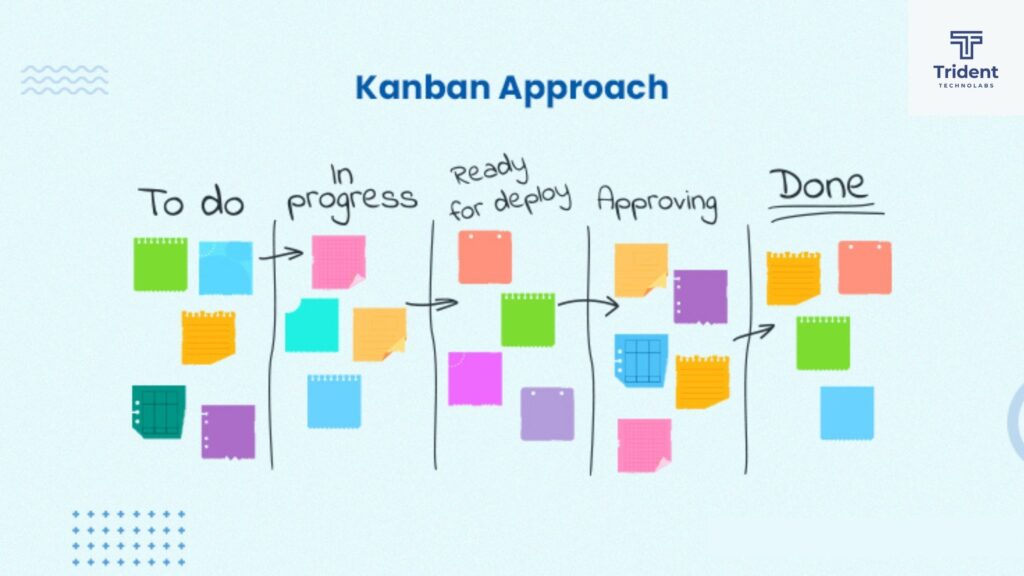
Kanban is another Agile project management methodology that enables continuous delivery of quality products while simplifying workflows. However, Kanban is exceptional for offering a highly visual method and a small amount of “work in progress” tasks to manage the project actively.
Kanban teams adhere to major software project management practices:
- Visualize the workflow
- Reduce work in progress
- Manage workflow
- Make clear policies
- Implement feedback loops
- Enhance collaboration
To help you pull off these practices, a Kanban board optimizes the visual approach with three columns at the basic level – To Do (pending tasks), Doing (in-progress tasks), and Done (completed tasks).
You can also add new tasks to the board as cards. Each one of the cards contains all the important data, such as checklists, documents, links, estimated date to complete, assigned team members, and other relevant details.
Moreover, you can set a limit to the number of work-in-progress tasks in this Agile programming method. So, if you hate meeting hard deadlines and want flexible project management, Kanban is the best bet for you.
Extreme Programming (XP)
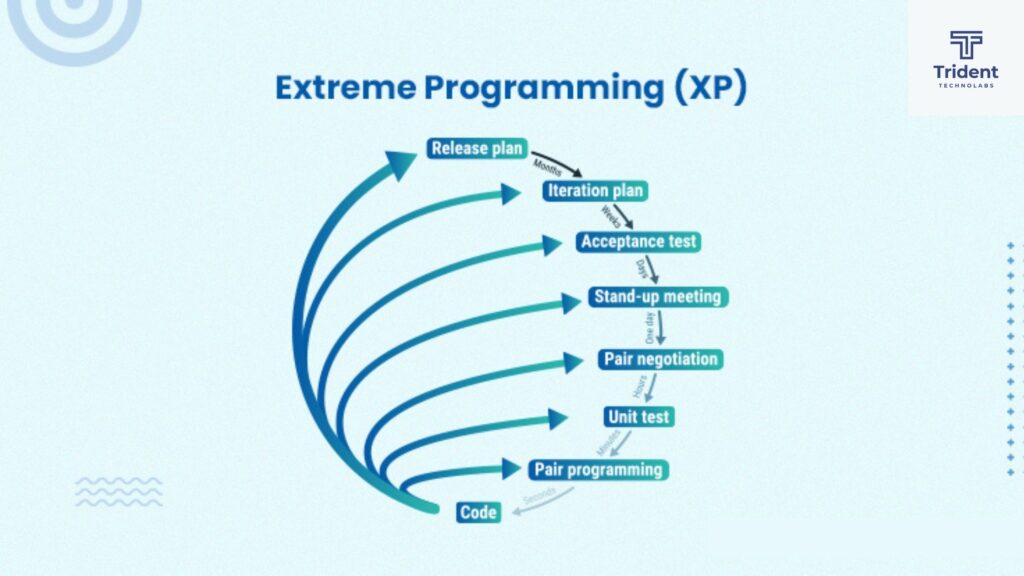
Don’t take the name of this Agile methodology in the Red Bull sense; Extreme Programming is not extreme but sure, a bit different from other practices.
At its core, XP is a more diligent approach to Agile that calls for close teamwork, continuous planning and testing, customer participation, and rapid feedback loops to develop effective software. For example, a standard XP sprint lasts for about 7-21 days.
Software engineer Kent Beck invented the original XP ‘recipe’ and built it on five core values:
- Courage
- Feedback
- Respect
- Communication
- Simplicity
Along with the values, XP Agile developers follow 12 practices, including the planning game, simple design, test-driven development (TDD), refactoring, and so on.
XP works with tight feedback loops where end-users closely work with the team outside of IT. So, if you hire expert software developers with XP ethos, your potential customers can comment on the greatest features of the product, and developers can utilize that feedback to improve the software until it’s completely ready to launch.
Lean Software Development (LSD)
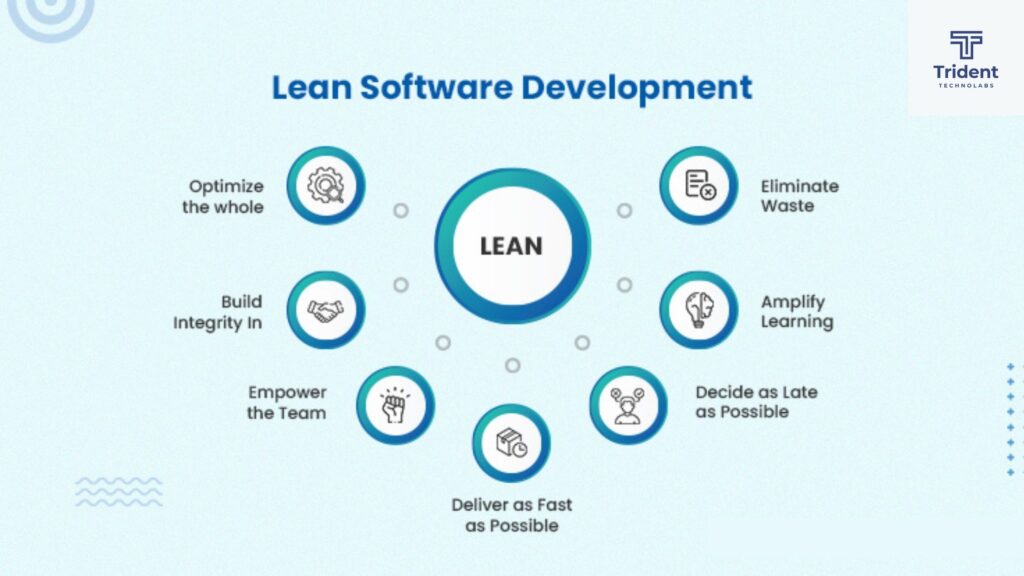
With lesser rules and guidelines, lean software development is a more flexible framework than XP or Scrum. This methodology relies on a set of practices and principles created to assure efficiency and value in the software development process in the mid 2oth century and has gradually advanced into the software environment.
The seven key principles of this Agile SDLC are:
- Eliminate waste
- Build quality in
- Create knowledge
- Defer commitment
- Deliver fast
- Respect people
- Optimize the whole
LSD is one of the dynamic approaches that navigate your project through cleanliness and productivity. Lean production includes prioritizing value-based features, using resources efficiently, empowering individuals and teams with decision-making skills, and terminating unproductive tasks and wasted time.
So, in case you are wondering how to manage an agile software development process in a short timeframe, following the Lean methodology can be a good choice.
Crystal
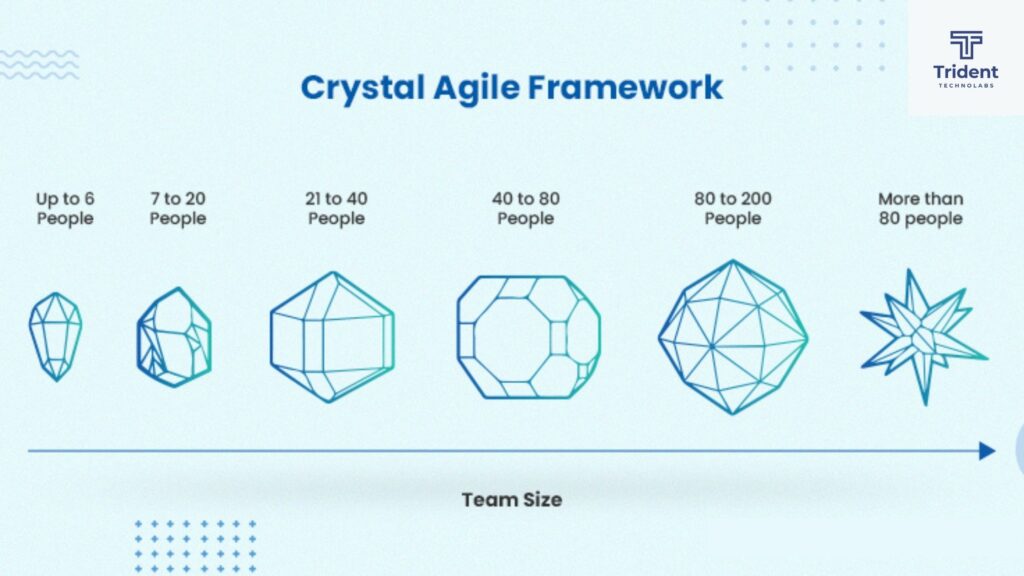
The crystal method in the Agile process emphasizes the importance of constructive interaction between team members as opposed to technologies and tools involved in a project. It is a lightweight framework that emerged as a direct offshoot of one of the key values of the Agile Manifesto.
Here are the three core criteria of Crystal project management:
- Team size
- Project priorities
- System integrity
The methodology is similar to other Agile processes in terms of critical involvement of customers, cutting off the red tape, and regular and fast delivery of software.
As per Crystal principles, every project is unique and such assertion has led to its recognition as one of the most flexible Agile frameworks for project management. So, if you want your team to work in the most effective way, this can be a feasible methodology for your organization.
Important Artifacts and Ceremonies in Agile Methodology
Agile artifacts are a set of pivotal tools that development teams need to achieve desired project goals. And if you are planning to adopt an Agile mindset, it becomes necessary to be familiar with the terms so that you can decipher them for your team.
So, before diving into the dynamics of Agile implementation, let’s go through the essential components your team will be utilizing.
Agile Artifacts
| Product Backlog | It’s an all-in-one list of all the things teams need to complete in order to deliver the product. The product owner is in charge of the backlog who regularly updates it with updates and feedback. Product backlog in Agile development consists of three primary items – user stories (feature description of the product), tasks (any tasks to complete), and bugs (product issues to fix). |
| Sprint Backlog | It consists of the future tasks included in the Sprint. During the Sprint planning meeting, the product owner, with the help of their team, creates this backlog and targets to complete the added tasks. |
| Epics | Epics and stories are highly convenient for executing long-term projects with detailed strategies. To give you an idea, Agile developers consider the whole project as an epic and each task included in it as a story. |
| Product Increment | Product increment represents the applicable version of the final software. It will provide the needed clarity to both your stakeholders and team as it covers every item completed in a Sprint. |
| Roadmaps | The term is pretty self-explanatory. Roadmaps will help you decide the timeframe of your project, i.e., when you want to finish developing the product. While it shows estimated dates, those are variable which you can change anytime needed. |
Agile Ceremonies
Quite a fancy name, right?
Ceremonies are the crucial events in Agile project management that will help you execute software project delivery by improving team communication and optimizing the feedback loop. Check out these five Agile ceremonies without which your software project might survive, but it might not go well.
Agile Ceremonies for Software Project
| Sprint Planning | Sprint planning is the preparation work that happens before Sprint starts. It takes about 1-2 hours a week. The whole team discusses the product backlog, picks certain tasks for Sprint backlog, and adds estimated story points for every task. |
| Daily Stand-Ups | In these 15-minutes quick meetings, team members discuss the completed tasks and the upcoming ones. The goal is to clear all the roadblocks and ensure the successful development of the Agile software. |
| Sprint Review | Sprint review is the showcasing and gathering feedback part after you complete a Sprint. Here, you demonstrate what has been done so far, collect feedback from everyone, and implement that on your future projects. |
| Sprint Retrospectives | Product increment represents the applicable version of the final software. It will provide the needed clarity to both your stakeholders and team as it covers every item completed in a Sprint. |
| Roadmaps | In this ceremony, the whole team reflects on the past Sprint to repeat what went well and improve what did not. The retrospective is basically a method of risk mitigation for upcoming Sprints. |
7 Great Benefits of Agile Software Development
For most businesses, the implementation of an agile enterprise architecture framework comes from a conscious decision to welcome change. No matter what your reason is, Agile offers a plethora of benefits that can help you meet your business goals more effectively.
In this section, we will touch upon some valuable Agile benefits that focuses on:
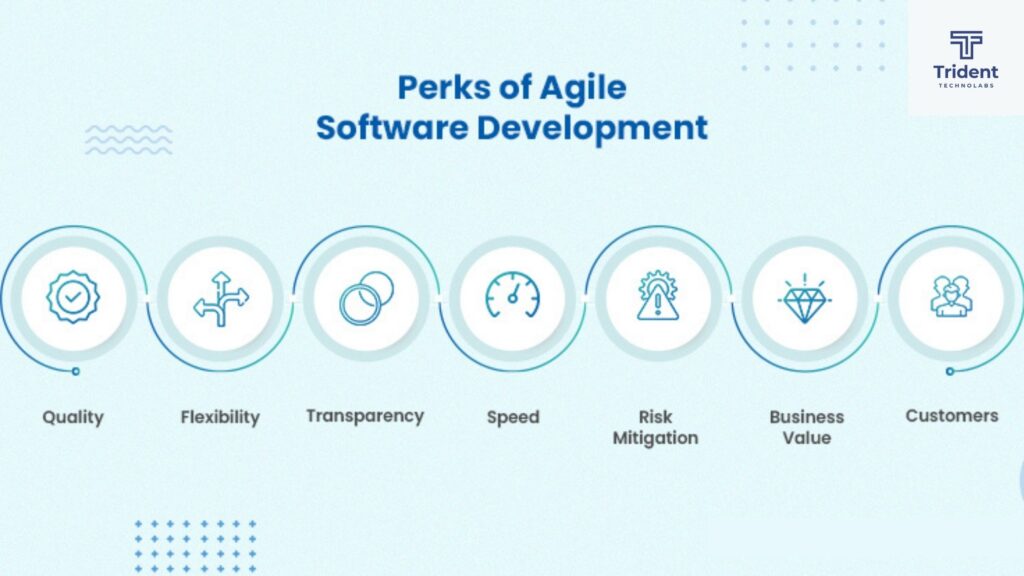
1. Quality
Agile practices allow you to break a project into small chunks so that it becomes easier for your team to work on, test, and review every iteration carefully. Hence, finding bugs and fixing them becomes a lot easier.
2. Speed
Speed is most probably the greatest advantage of Agile. Regular and fast software releases enable developers to be always ready with a part of the completed product. Hence, “accelerated product delivery” is where Agile methodology wins out the most.
3. Customers
More than anything, Agile spotlights the uninterrupted delivery of high-quality software. It emphasizes customer satisfaction and the direct influence of their feedback on product development.
4. Flexibility
Agile empowers you to reclarify and prioritize the most important components of a product – even if you change them every week. You can easily filter your backlogged goals into future iterations.
5. Transparency
Enhanced collaboration, teamwork, and user engagement are the direct outcomes of embracing Agile methods. Stakeholders at all levels can look into processes and share their feedback.
6. Business Value
Maximizing customer satisfaction leads to increased business value. There are agile metrics that ensure your product closely aligns with the customers’ expectations which, in return, shoots up your brand value.
7. Risk Mitigation
Agile methodology steps help in creating iterations so that you can adapt to a changing software setting. With incremental releases of software, you can detect issues and bugs and fix them earlier before finalizing the software and making it more difficult to fix.
5 Major Drawbacks of Agile Software Development
While Agile might be an exceptional choice for a great many development firms, it is not always the perfect fit for everyone. So, consider these five major disadvantages of the Agile process before adopting it:
1. Delivery Can Outshine Quality
Agile demands continuous software iterations. Hence, quality assurance is very likely to fall into the pit of endless backlog.
2. Not Great for Large Organizations
If you have a large-size company that tends to be inflexible, Agile is not the right choice for you. Due to its need for utmost transparency and lack of documentation, big companies will feel hamstrung by this methodology.
3. Cost of Change
More often than not, people change crucial things late in the development process, thinking that since it’s Agile project management that can manage everything. As you keep adding iterations, the codebase keeps changing, and hence, it becomes difficult to fix some issues that you might have easily fixed earlier.
4. Training Requirement
As per the State of Agile reports, “lack of adequate experience” is the biggest reason Agile SDLC methodologies fail in organizations. While the Waterfall methodology is more intuitive, you need a bit more time to get along with Agile.
5. Fragmented Output
Agile enables incremented delivery which is a key factor for a faster time to market. But it can also be a significant drawback as working on each element in different iterations often results in a fragmented output instead of one cohesive unit.
Is Agile Software Development a Right Choice for Your Organization?
Pretty much every major software and product development company across the globe fosters an Agile mindset. But don’t be overwhelmed by this fact. Remember that it’s not the one and only project management methodology out there.
Agile might be a far cry from how your team used to work. It helps you move quickly, meaning you have to brainstorm and plan everything beforehand. Hence, you must know whether your organization is ready to handle such a change.
Here are five basic questions that you need to answer honestly before going all-in on Agile.
1. Are you ready to take on a project without knowing the final outcome?
Fault first, win next – this quote perfectly goes with Agile methodology. In case you are a control freak, continuously testing and moving forward can be stressful at times.
So, adopt Agile only when you are fully comfortable with releasing a not-so-finished product and considering software prototype which is a crucial part of your development process. If you feel like you need to bake your software before it sees the light of the day, you will not get the best results that Agile offers.
2. Is your team flexible enough?
Agile emphasizes customer satisfaction and feedback above everything. You need to trust your uses to make the product better. And this approach does not always go well with designers, developers, and other stakeholders. Hence, ensure your key players are ready to accept a different point of view and fine-tune their efforts according to the users’ needs.
3. Are you willing to take risks?
As mentioned before, Agile programming is all about learning from mistakes and implementing changes. Unlike traditional methods, here you have to sign up for a higher level of risks.
So, are you standing at the edge of failure where everything must be perfect? Or do you have a speak-off-the-cuff organizational culture where you are ready to embrace risks?
4. What is success and progress for you?
Agile development and shiny new object syndrome do not go hand in hand. The latter is all about constantly working so that you can improve your product.
If you think your team will chase the next great idea and leave behind the last one, Agile is not the greatest option for you. Take some time to understand what success means to you. Will you be happy with the small yet significant achievements that take you closer to your targets? Or does the big win only matter to you?
5. Do you have a strict organizational hierarchy?
Developers having regular and transparent access to major stakeholders – this is one of the primary values of Agile. And this might be a stretch for some firms.
So, how is your organizational culture? Will your stakeholders happily be a key part of the overall process? Or is there a firm hierarchy that’s hard to change?
How Can Trident Technolabs Help You with Agile Project Management?
Agile is a lot more than just a project management craze. At its heart, Agile is a set of disciplines that require a progressive mindset and vigorous initiatives. A significant part of Agile is to embrace change, and so, figuring this methodology out is a big slice of the overall journey.
And while such a transitional journey might not be easy for everyone, we can help you with the same. With more than two decades of industry experience, our seasoned developers are well-versed with the nitty-gritty of the Agile process who can help you build high-quality software with cutting-edge features and functionalities.
So, let’s take a shot at top-notch software development company with our Agile experts and welcome a revolutionary change in your business paradigms. Once your team is on board, we will be waiting for you to come back and tell how much everyone loves it.
It’s your call to make your team Agile or fragile!


Leave a comment: